Abstract
1. Six well-trained cyclists and six untrained subjects were studied during and immediately after four successive 7 min periods of exercise at 30, 45, 60 and 75% of their maximal work capacity. 2. Venous blood samples were taken at rest, at the end of each exercise period and 5 min following the end of exercise, for estimation of metabolites in blood and plasma insulin, growth hormone, cortisol and catecholamines. 3. The results showed significant differences in the mobilization and utilization of muscle fuels between the athletically fit cyclists and the untrained group. In the cyclists, glucose, glycerol and free fatty acid concentrations were higher, but lactate, pyruvate and alanine were lower than in the untrained subjects during exercise. 4. Plasma catecholamines rose in both groups during exercise but the rise was significantly less in the racing cyclists. Plasma insulin was depressed to a greater extent in the untrained subjects during exercise and plasma glucagon rose to a greater extent during strenuous exercise and remained elevated after the end of exercise in the untrained group. Plasma human growth hormone rose to a greater extent during exercise and remained elevated after the end of exercise in the untrained group. Plasma cortisol fell at low and moderate exercise rates in both groups, but to a smaller extent in the cyclists. Cortisol values rose at higher workloads and were significantly higher in the cyclists at the end of exercise. 5. It is concluded that there are significant differences in the metabolic and hormonal responses to exercise between athletically trained and untrained individuals, even when the physically fit subjects work at the same percentage of their maximal capacity as the unfit subjects.
Full text
PDF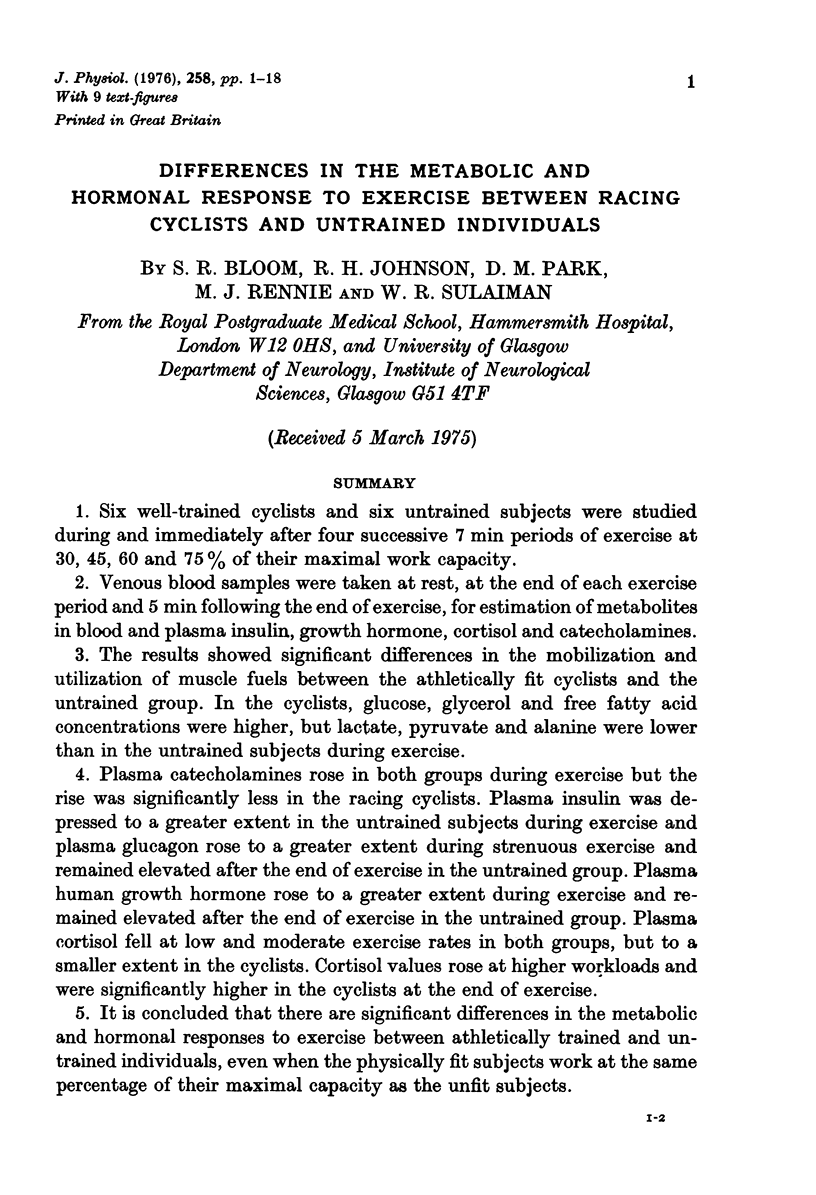
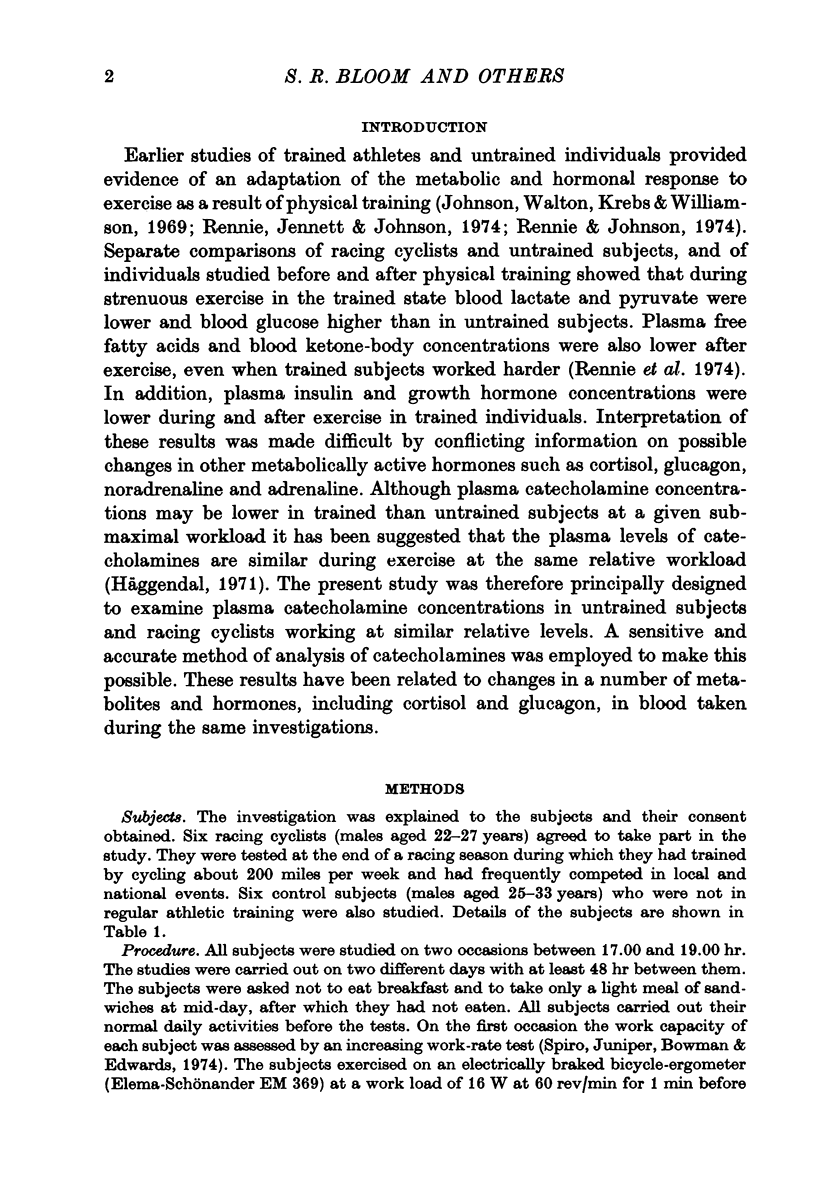
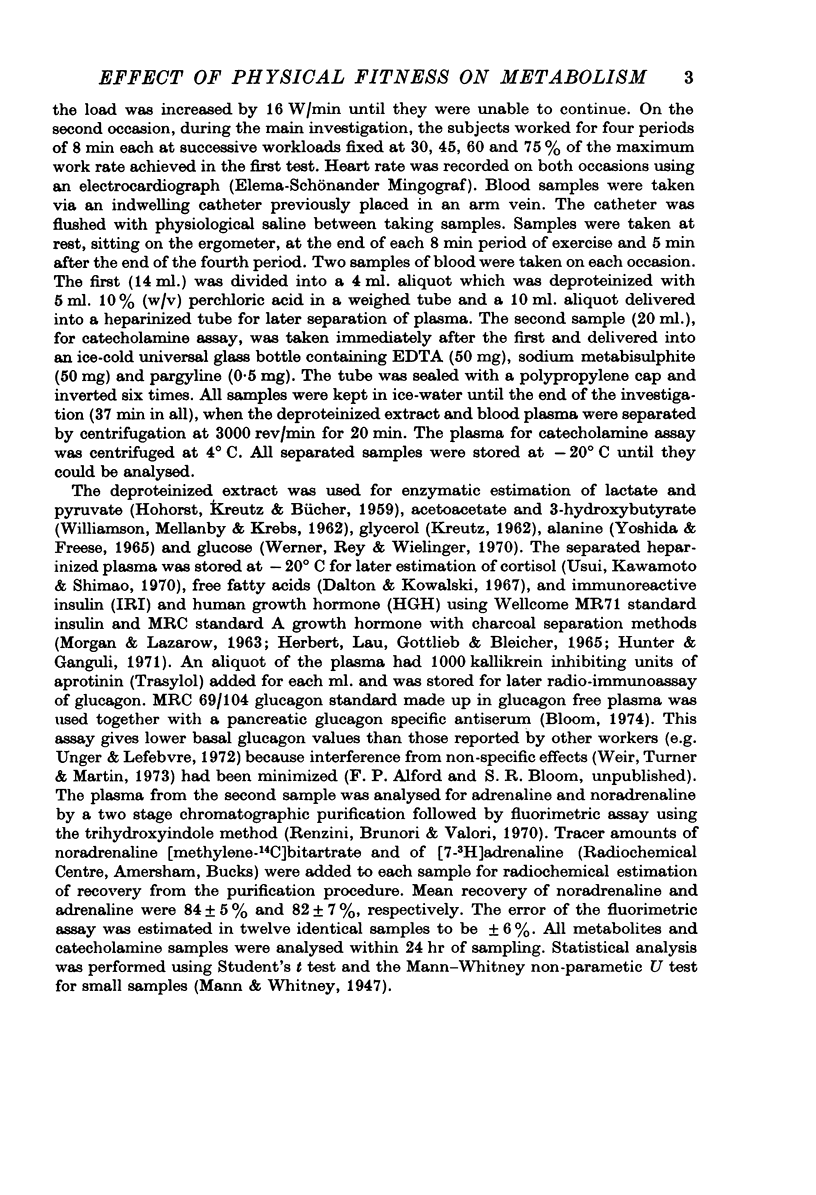
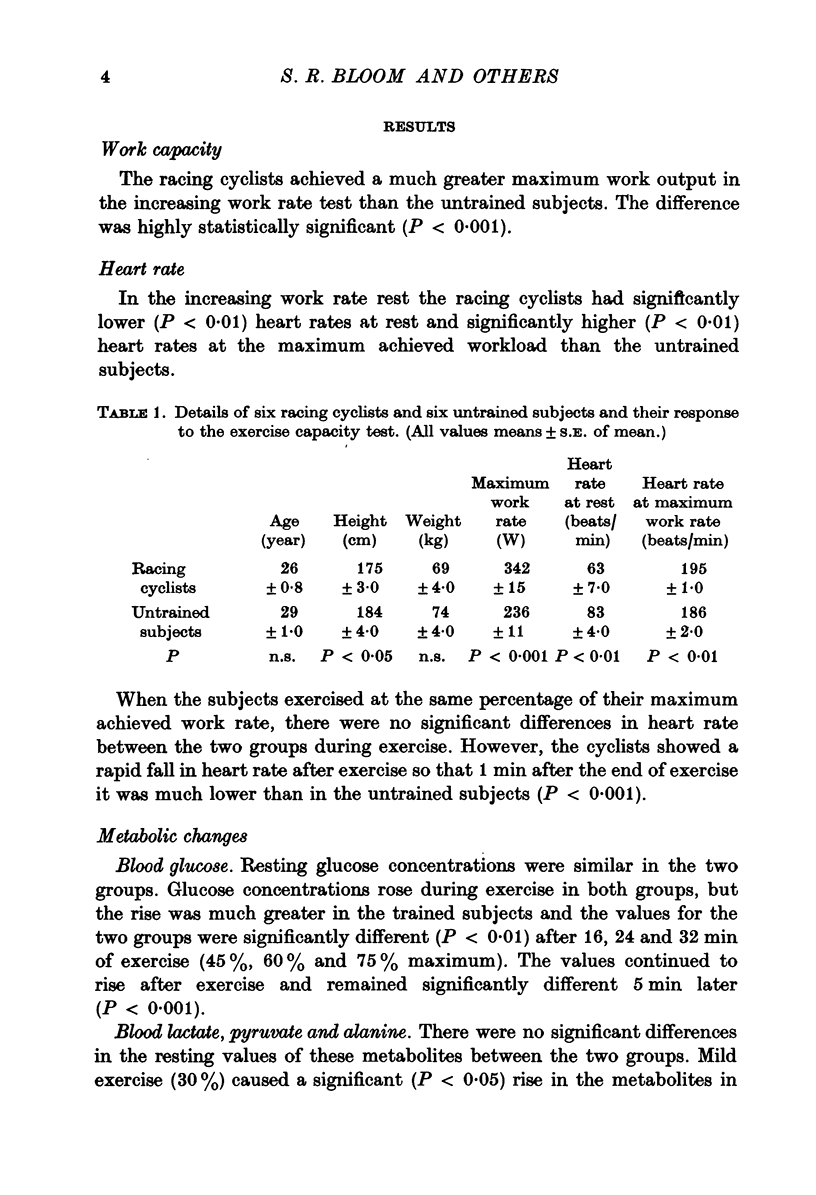
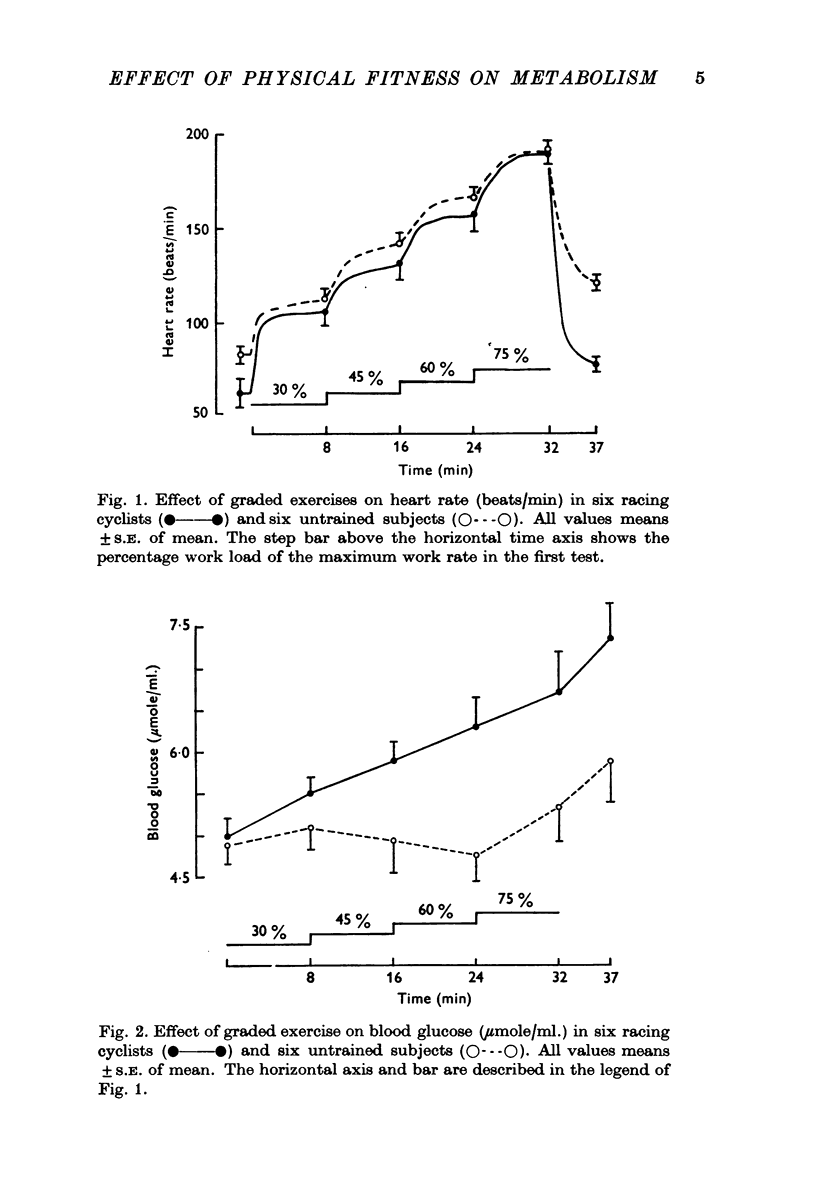
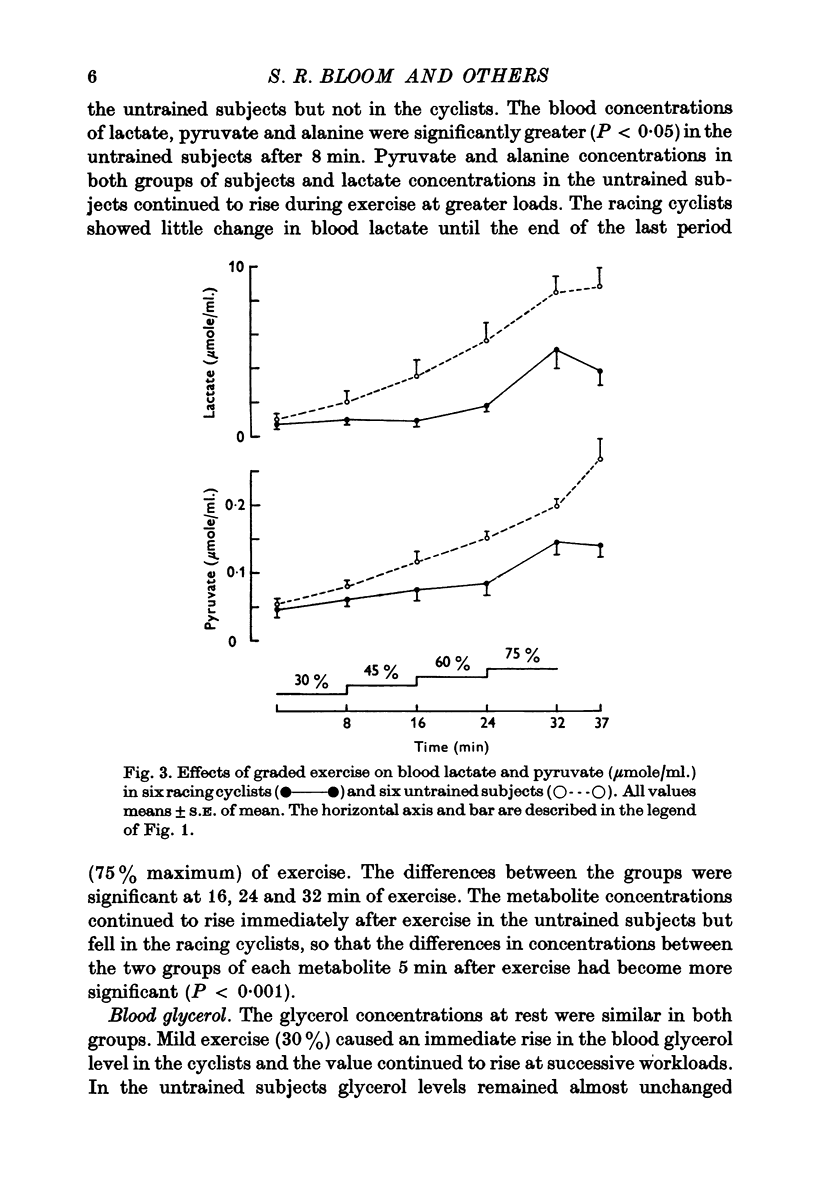
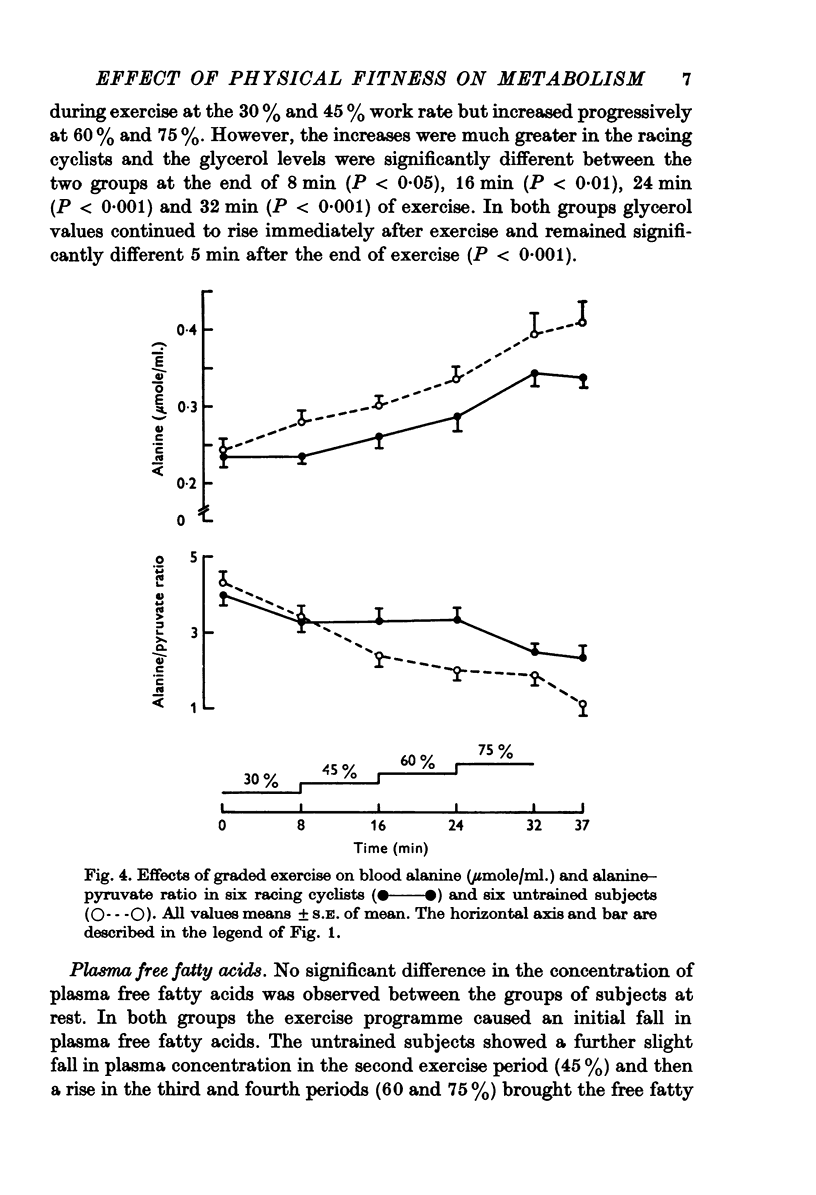
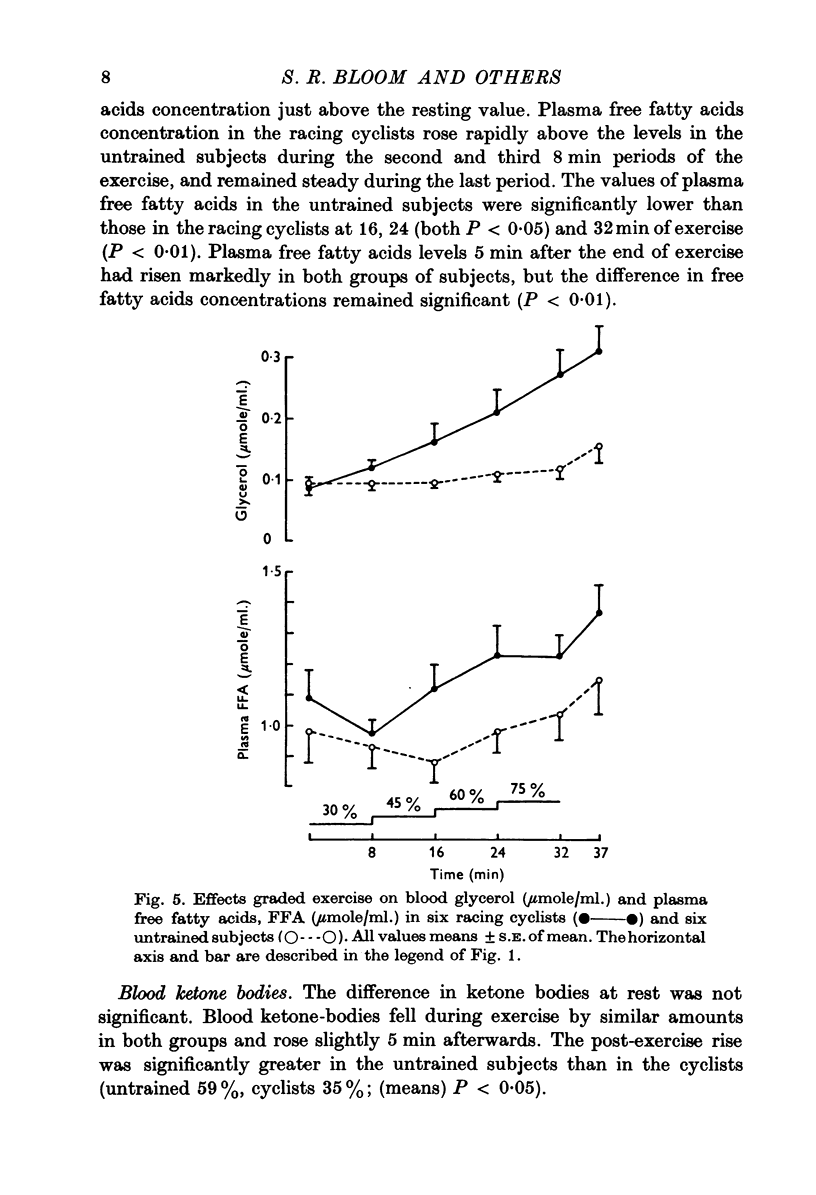
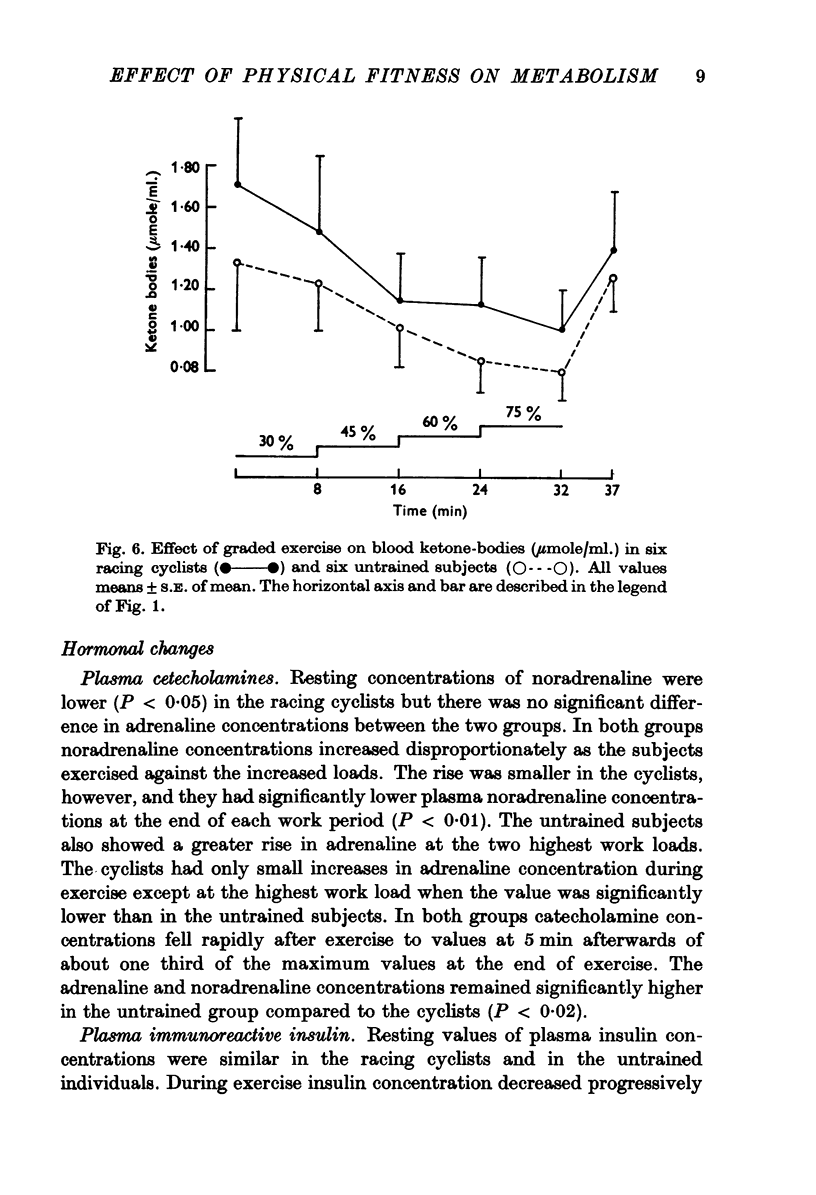
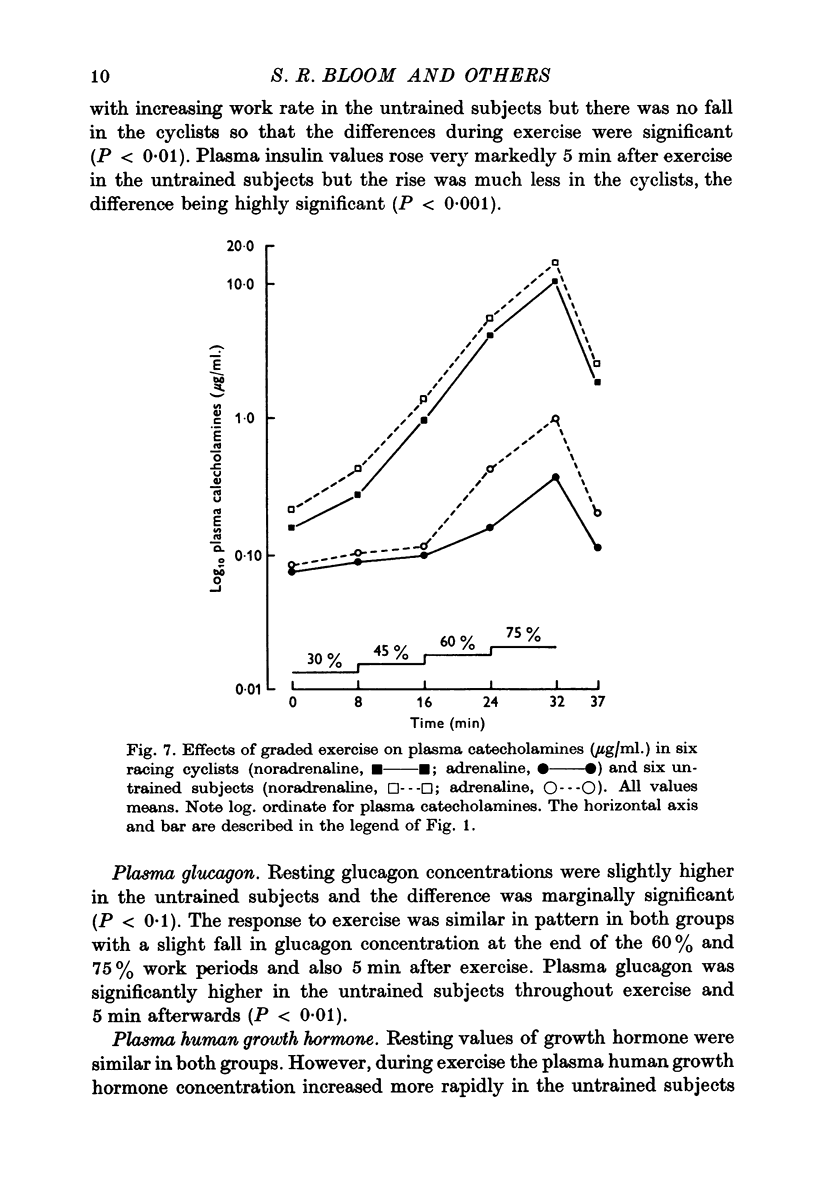
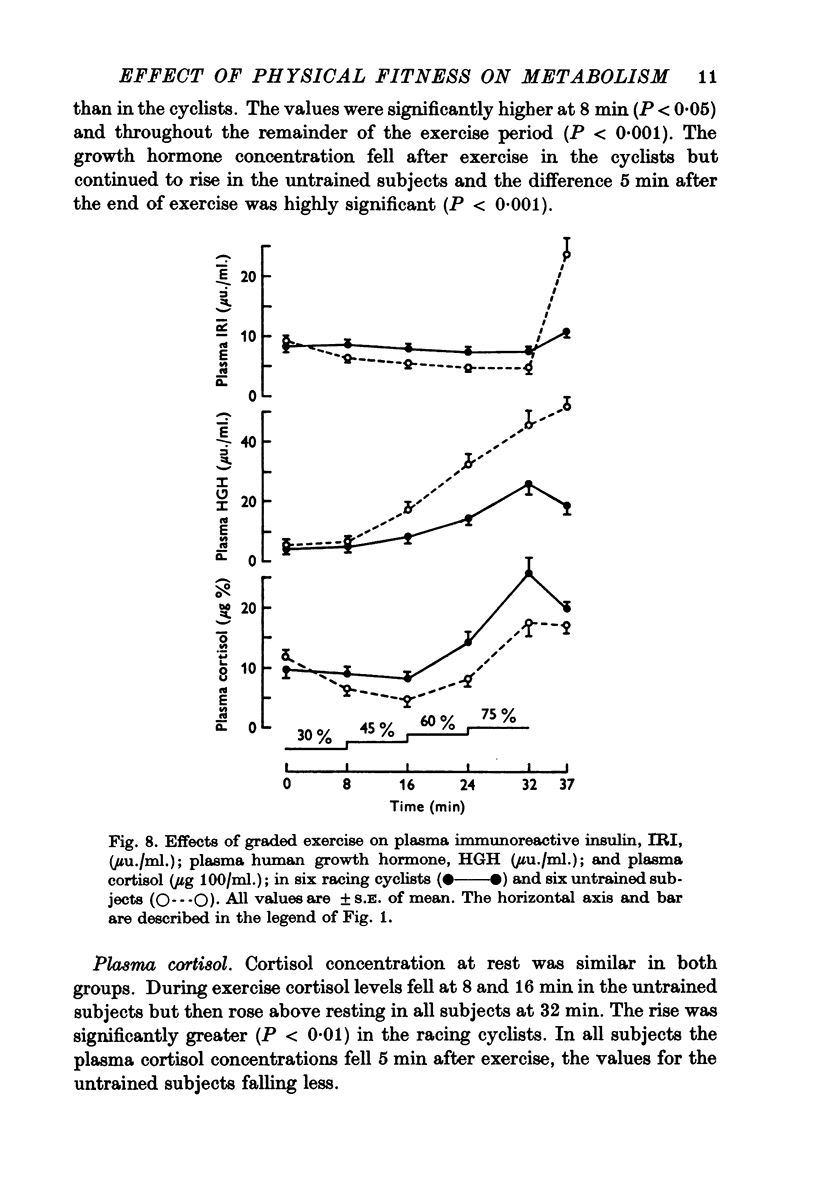
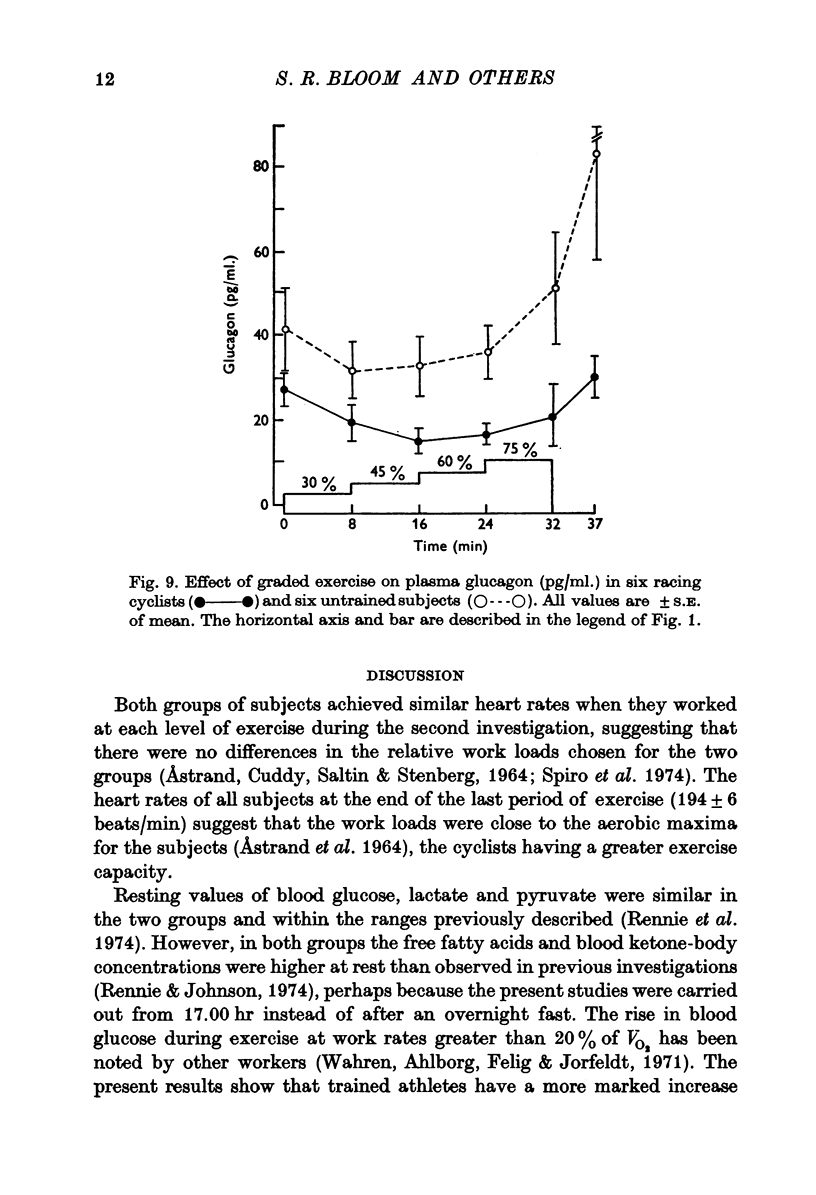
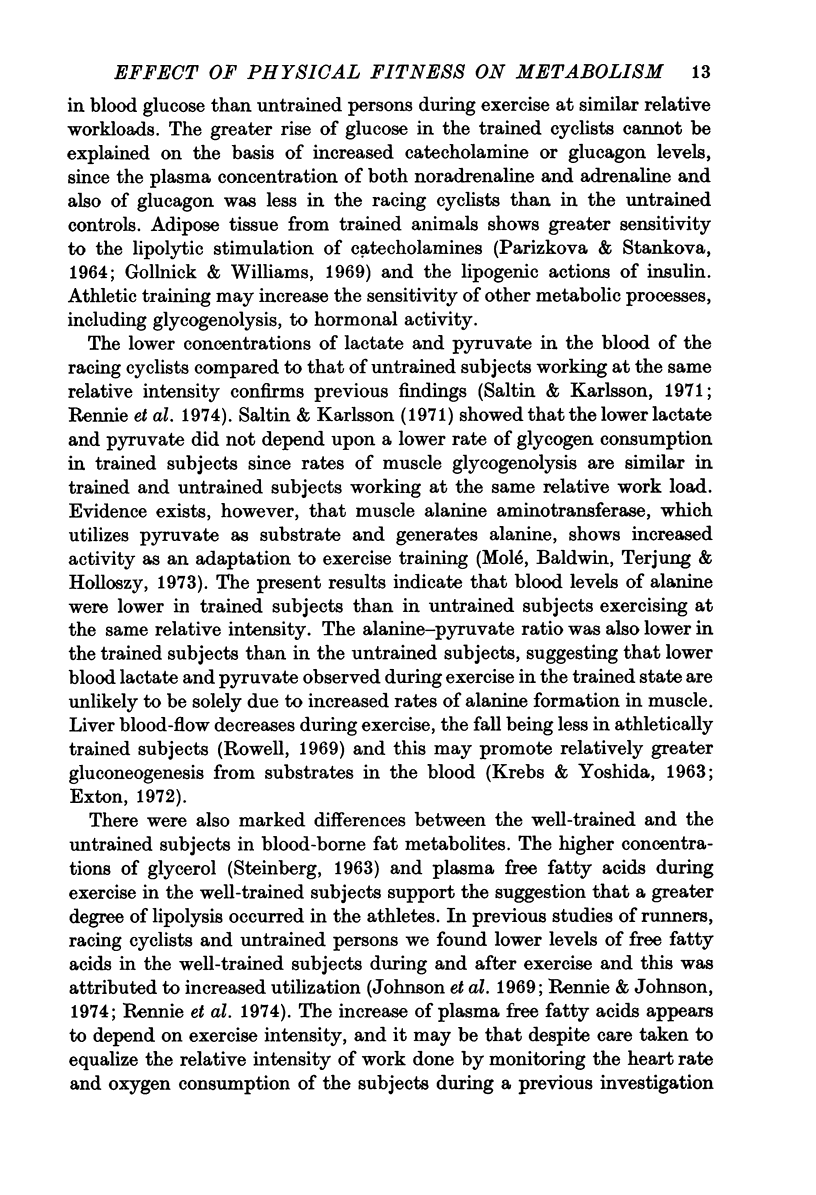
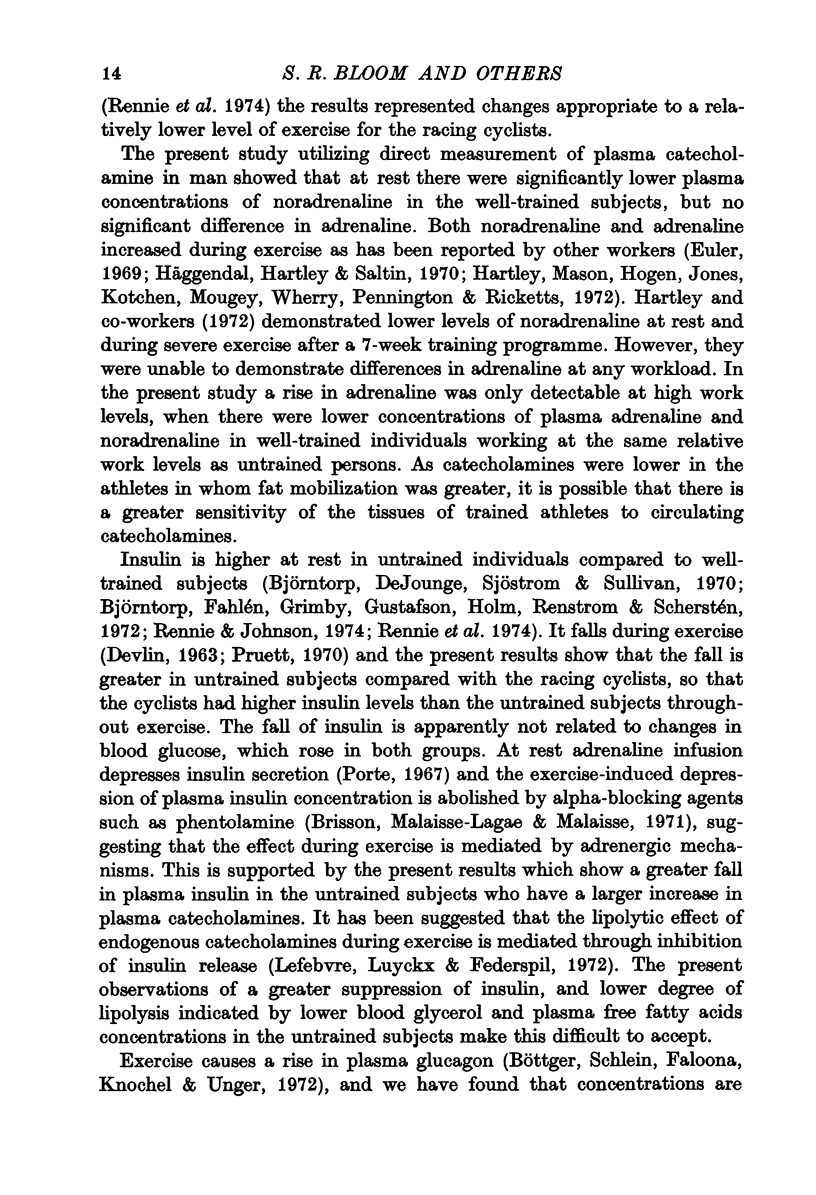
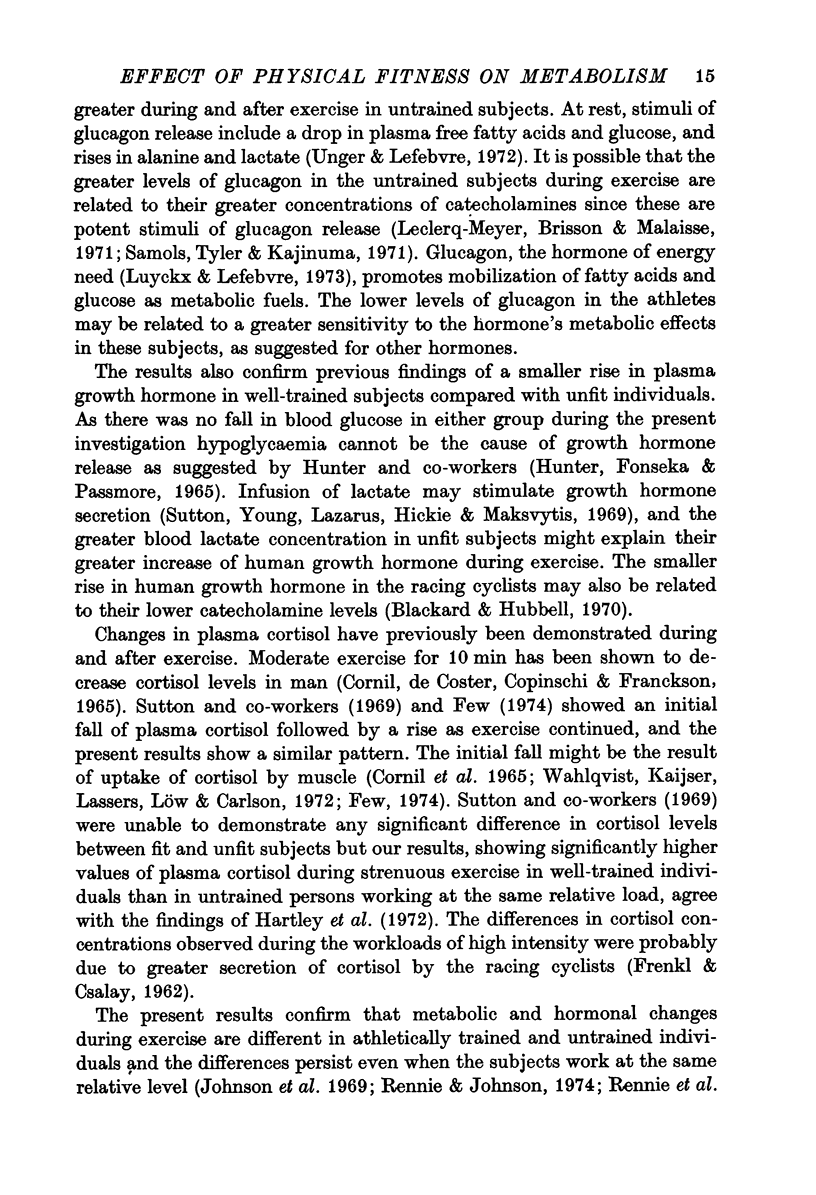
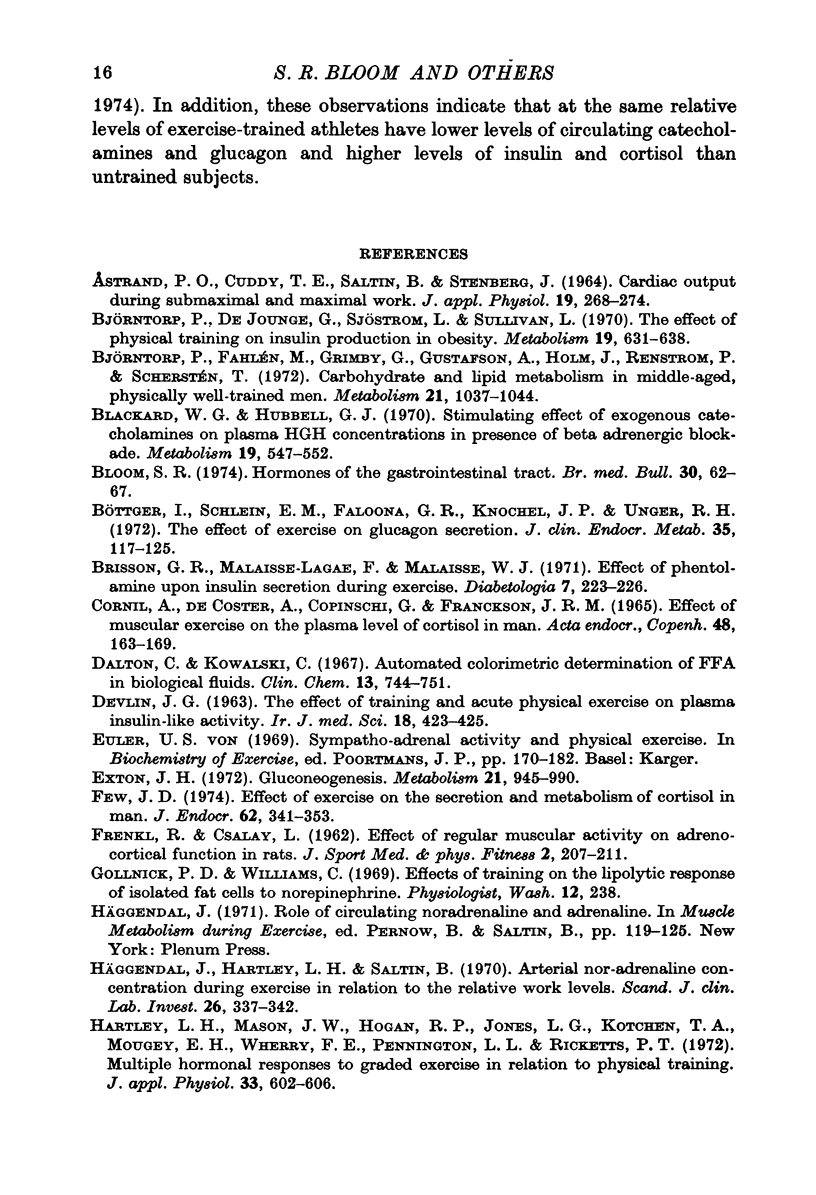
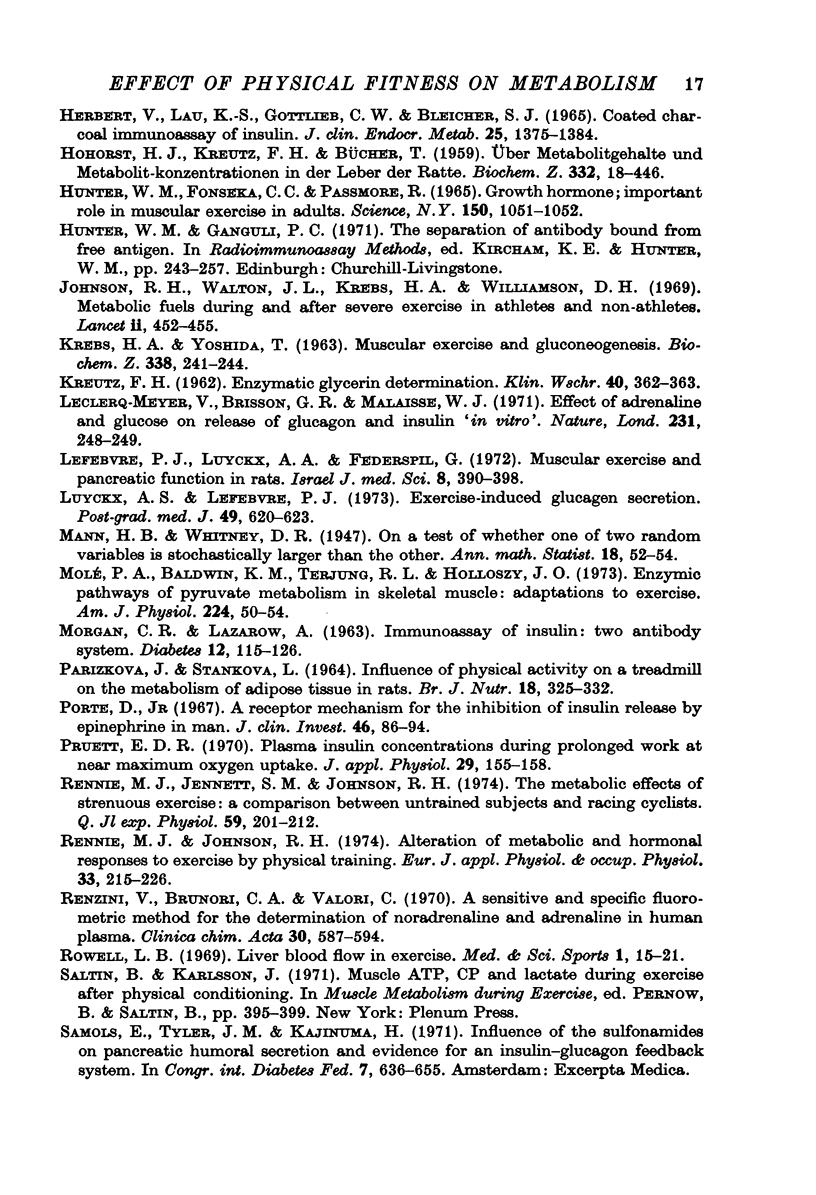
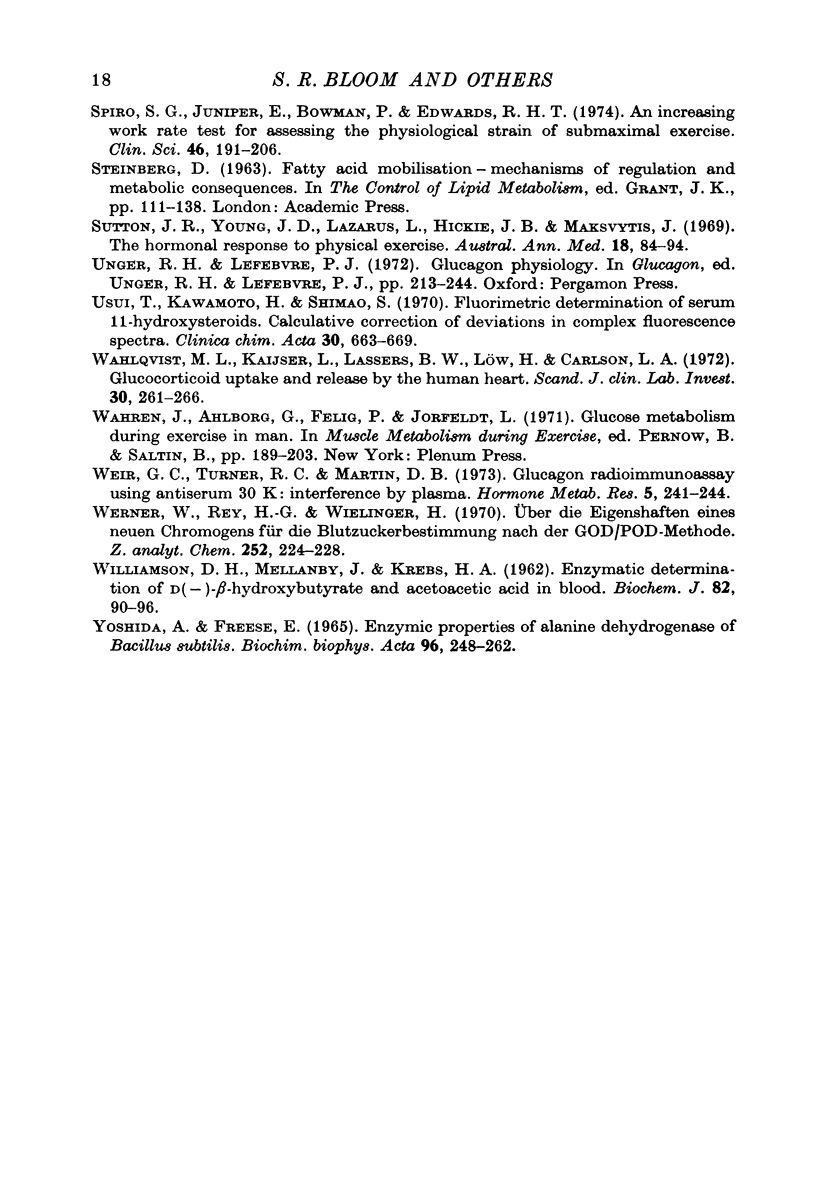
Selected References
These references are in PubMed. This may not be the complete list of references from this article.
- ASTRAND P. O., CUDDY T. E., SALTIN B., STENBERG J. CARDIAC OUTPUT DURING SUBMAXIMAL AND MAXIMAL WORK. J Appl Physiol. 1964 Mar;19:268–274. doi: 10.1152/jappl.1964.19.2.268. [DOI] [PubMed] [Google Scholar]
- Björntorp P., De Jounge K., Sjöström L., Sullivan L. The effect of physical training on insulin production in obesity. Metabolism. 1970 Aug;19(8):631–638. doi: 10.1016/0026-0495(70)90020-x. [DOI] [PubMed] [Google Scholar]
- Björntorp P., Fahlén M., Grimby G., Gustafson A., Holm J., Renström P., Scherstén T. Carbohydrate and lipid metabolism in middle-aged, physically well-trained men. Metabolism. 1972 Nov;21(11):1037–1044. doi: 10.1016/0026-0495(72)90034-0. [DOI] [PubMed] [Google Scholar]
- Blackard W. G., Hubbell G. J. Stimulatory effect of exogenous catecholamines on plasma HGH concentrations in presence of beta adrenergic blockade. Metabolism. 1970 Jul;19(7):547–552. doi: 10.1016/0026-0495(70)90010-7. [DOI] [PubMed] [Google Scholar]
- Bloom S. R. Hormones of the gastrointestinal tract. Br Med Bull. 1974 Jan;30(1):62–67. doi: 10.1093/oxfordjournals.bmb.a071169. [DOI] [PubMed] [Google Scholar]
- Brisson G. R., Malaisse-Lagae F., Malaisse W. J. Effect of phentolamine upon insulin secretion during exercise. Diabetologia. 1971 Aug;7(4):223–226. doi: 10.1007/BF01211872. [DOI] [PubMed] [Google Scholar]
- Böttger I., Schlein E. M., Faloona G. R., Knochel J. P., Unger R. H. The effect of exercise on glucagon secretion. J Clin Endocrinol Metab. 1972 Jul;35(1):117–125. doi: 10.1210/jcem-35-1-117. [DOI] [PubMed] [Google Scholar]
- CORNIL A., DECOSTER A., COPINSCHI G., FRANCKSON J. R. EFFECT OF MUSCULAR EXERCISE ON THE PLASMA LEVEL CORTISOL IN MAN. Acta Endocrinol (Copenh) 1965 Jan;48:163–168. doi: 10.1530/acta.0.0480163. [DOI] [PubMed] [Google Scholar]
- Dalton C., Kowalski C. Automated colorimetric determination of free fatty acids in biologic fluids. Clin Chem. 1967 Sep;13(9):744–751. [PubMed] [Google Scholar]
- Exton J. H. Gluconeogenesis. Metabolism. 1972 Oct;21(10):945–990. doi: 10.1016/0026-0495(72)90028-5. [DOI] [PubMed] [Google Scholar]
- FRENKL R., CSALAY L. Effect of regular muscular activity on adrenocortical function in rats. J Sports Med Phys Fitness. 1962 Dec;2:207–211. [PubMed] [Google Scholar]
- Few J. D. Effect of exercise on the secretion and metabolism of cortisol in man. J Endocrinol. 1974 Aug;62(2):341–353. [PubMed] [Google Scholar]
- Hartley L. H., Mason J. W., Hogan R. P., Jones L. G., Kotchen T. A., Mougey E. H., Wherry F. E., Pennington L. L., Ricketts P. T. Multiple hormonal responses to graded exercise in relation to physical training. J Appl Physiol. 1972 Nov;33(5):602–606. doi: 10.1152/jappl.1972.33.5.602. [DOI] [PubMed] [Google Scholar]
- Herbert V., Lau K. S., Gottlieb C. W., Bleicher S. J. Coated charcoal immunoassay of insulin. J Clin Endocrinol Metab. 1965 Oct;25(10):1375–1384. doi: 10.1210/jcem-25-10-1375. [DOI] [PubMed] [Google Scholar]
- Häggendal J., Hartley L. H., Saltin B. Arterial noradrenaline concentration during exercise in relation to the relative work levels. Scand J Clin Lab Invest. 1970 Dec;26(4):337–342. doi: 10.3109/00365517009046242. [DOI] [PubMed] [Google Scholar]
- Johnson R. H., Walton J. L., Krebs H. A., Williamson D. H. Metabolic fuels during and after severe exercise in athletes and non-athletes. Lancet. 1969 Aug 30;2(7618):452–455. doi: 10.1016/s0140-6736(69)90164-0. [DOI] [PubMed] [Google Scholar]
- KREBS H. A., YOSHIDA T. MUSCULAR EXERCISE AND GLUCONEOGENESIS. Biochem Z. 1963;338:241–244. [PubMed] [Google Scholar]
- KREUTZ F. H. [Enzymatic glycerin determination]. Klin Wochenschr. 1962 Apr 1;40:362–363. doi: 10.1007/BF01732450. [DOI] [PubMed] [Google Scholar]
- Leclercq-Meyer V., Brisson G. R., Malaisse W. J. Effect of adrenaline and glucose on release of glucagon and insulin in vitro. Nat New Biol. 1971 Jun 23;231(25):248–249. doi: 10.1038/newbio231248a0. [DOI] [PubMed] [Google Scholar]
- Lefebvre P. J., Luyckx A. S., Federspil G. Muscular exercise and pancreatic function in rats. Isr J Med Sci. 1972 Mar;8(3):390–398. [PubMed] [Google Scholar]
- Molé P. A., Baldwin K. M., Terjung R. L., Holloszy J. O. Enzymatic pathways of pyruvate metabolism in skeletal muscle: adaptations to exercise. Am J Physiol. 1973 Jan;224(1):50–54. doi: 10.1152/ajplegacy.1973.224.1.50. [DOI] [PubMed] [Google Scholar]
- PARIZKOVA J., STANKOVA L. INFLUENCE OF PHYSICAL ACTIVITY ON A TREADMILL ON THE METABOLISM OF ADIPOSE TISSUE IN RATS. Br J Nutr. 1964;18:325–332. doi: 10.1079/bjn19640031. [DOI] [PubMed] [Google Scholar]
- Porte D., Jr A receptor mechanism for the inhibition of insulin release by epinephrine in man. J Clin Invest. 1967 Jan;46(1):86–94. doi: 10.1172/JCI105514. [DOI] [PMC free article] [PubMed] [Google Scholar]
- Rennie M. J., Jennett S., Johnson R. H. The metabolic effects of strenuous exercise: a comparison between untrained subjects and racing cyclists. Q J Exp Physiol Cogn Med Sci. 1974 Jul;59(3):201–212. doi: 10.1113/expphysiol.1974.sp002262. [DOI] [PubMed] [Google Scholar]
- Rennie M. J., Johnson R. H. Alteration of metabolic and hormonal responses to exercise by physical training. Eur J Appl Physiol Occup Physiol. 1974;33(3):215–226. doi: 10.1007/BF00421149. [DOI] [PubMed] [Google Scholar]
- Renzini V., Brunori C. A., Valori C. A sensitive and specific fluorimetric method for the determination of noradrenalin and adrenalin in human plasma. Clin Chim Acta. 1970 Dec;30(3):587–594. doi: 10.1016/0009-8981(70)90249-4. [DOI] [PubMed] [Google Scholar]
- Spiro S. G., Juniper E., Bowman P., Edwards R. H. An increasing work rate test for assessing the physiological strain of submaximal exercise. Clin Sci Mol Med. 1974 Feb;46(2):191–206. doi: 10.1042/cs0460191. [DOI] [PubMed] [Google Scholar]
- Steinberg D. Fatty acid mobilization--mechanisms of regulation and metabolic consequences. Biochem Soc Symp. 1963;24:111–143. [PubMed] [Google Scholar]
- Sutton J. R., Young J. D., Lazarus L., Hickie J. B., Maksvytis J. The hormonal response to physical exercise. Australas Ann Med. 1969 May;18(2):84–90. doi: 10.1111/imj.1969.18.2.84. [DOI] [PubMed] [Google Scholar]
- Usui T., Kawamoto H., Shimao S. Fluorimetric determination of serum 11-hydroxysteroids. Calculative correction of deviations in complex fluorescence spectra. Clin Chim Acta. 1970 Dec;30(3):663–669. [PubMed] [Google Scholar]
- WILLIAMSON D. H., MELLANBY J., KREBS H. A. Enzymic determination of D(-)-beta-hydroxybutyric acid and acetoacetic acid in blood. Biochem J. 1962 Jan;82:90–96. doi: 10.1042/bj0820090. [DOI] [PMC free article] [PubMed] [Google Scholar]
- Wahlqvist M. L., Kaijser L., Lassers B. W., Löw H., Carlson L. A. Glucocorticoid uptake and release by the human heart: studies at rest, during prolonged exercise, and during nicotinic acid infusion. Scand J Clin Lab Invest. 1972 Nov;30(3):261–266. doi: 10.3109/00365517209084288. [DOI] [PubMed] [Google Scholar]
- Weir G. C., Turner R. C., Martin D. B. Glucagon radioimmunoassay using antiserum 30K: interference by plasma. Horm Metab Res. 1973 Jul;5(4):241–244. doi: 10.1055/s-0028-1093958. [DOI] [PubMed] [Google Scholar]
- YOSHIDA A., FREESE E. ENZYMATIC PROPERTIES OF ALANINE DEHYDROGENASE OF BACILLUS SUBTILIS. Biochim Biophys Acta. 1965 Feb 22;96:248–262. [PubMed] [Google Scholar]


